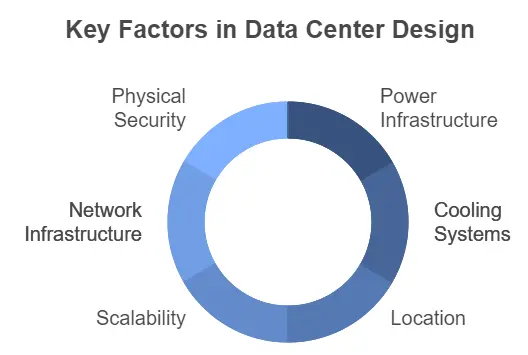Designing and building a modern data center requires careful planning and consideration of multiple factors. Whether you're building a new facility or upgrading an existing one, here are six critical factors that should guide your design process.
1. Power Infrastructure and Efficiency
The backbone of any data center is its power infrastructure. At the core of this consideration is power redundancy systems to ensure continuous operation. Your uninterruptible power supply (UPS) configuration must be carefully selected based on your reliability requirements and budget constraints. Power density planning is equally crucial – you'll need to determine the watts per square foot based on your equipment specifications and future needs. Modern data centers are increasingly focused on energy efficiency, measured through Power Usage Effectiveness (PUE). This often leads to exploring green energy options and implementing sustainable practices that can both reduce costs and meet corporate environmental goals.
2. Cooling Systems
Thermal management is paramount for maintaining equipment reliability and efficiency in your data center. Your cooling architecture decisions will significantly impact both performance and operating costs. Whether you opt for traditional raised floors, modern in-row cooling, or cutting-edge liquid cooling solutions, your choice should align with your specific needs and constraints. Airflow management through hot and cold aisle containment has become standard practice in modern facilities. Many modern data centers are also incorporating free cooling options, using outside air when conditions permit to reduce cooling costs. Humidity control remains a critical factor, requiring careful balance to prevent both static electricity and condensation issues.
3. Physical Security and Access Control
Data center security must be comprehensive and multi-layered, starting from the perimeter and extending to the rack level. A robust security system begins with strong perimeter protection and extends inward with increasingly stringent access controls. Modern facilities typically employ a combination of biometric systems and key cards, often incorporating mantrap entries for additional protection. Continuous monitoring through 24/7 surveillance systems helps maintain security integrity, while detailed documentation of all access events provides an audit trail. Your security design should include clear emergency protocols that can respond to various threat levels while maintaining operational continuity.
4. Network Infrastructure
Your network infrastructure forms the circulatory system of the data center. Connectivity redundancy is essential, achieved through multiple carrier options and diverse path routing. Your network topology should be selected based on both current requirements and anticipated future needs. The cabling infrastructure must be planned to support growth and changes without requiring major renovations. Bandwidth capacity planning should look several years ahead, considering the exponential growth in data requirements. Network security infrastructure must be robust, incorporating various protective measures while maintaining performance.
5. Scalability and Future Growth
A well-designed data center must accommodate future expansion without requiring a complete redesign. Modular design approaches allow for phased growth and equipment updates without disrupting existing operations. Your space planning should include reserved areas for future equipment and power needs, while infrastructure capacity should include appropriate headroom for growth. The design should maintain flexibility to adopt new technologies as they emerge, and account for the trend toward increasing rack densities.
6. Location and Environmental Factors
Site selection and environmental considerations have long-lasting implications for your data center's success. Natural disaster risk assessment must consider potential threats from earthquakes, floods, and storms in your chosen location. Power availability at the site is crucial, including evaluation of local power grid reliability and costs. Local climate conditions will significantly impact your cooling requirements and operating costs. Additionally, you must ensure compliance with local building codes and environmental regulations, which can vary significantly by location.

When designing a data center, these factors must be considered together. Their interdependencies will influence your decisions and trade-offs. Regular reassessment of these factors ensures your data center remains efficient, secure, and capable of meeting evolving business needs.
Remember that while there are industry best practices, each data center's specific requirements will vary based on its purpose, scale, and organizational needs. Working with experienced designers and consultants can help navigate these complex decisions and create a facility that balances performance, reliability, and cost-effectiveness.